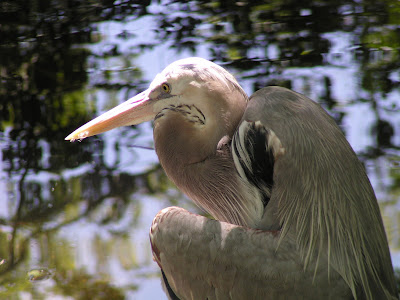

 The panhandle beaches are some of the best in Florida. The sand is bright white and soft as sugar and the water is usually beautiful. The photo of Bonnie and the first photo below were taken at Santa Rosa Beach. It was open and uncrowded so we took the opportunity to bask and work on our tans. The second photo was taken west of Panama City Beach. Much of that beach is lined with hi-rise condos and hotels. Some can be seen in the distance. Public beach access in that area is controlled and not available to us common folks.
The panhandle beaches are some of the best in Florida. The sand is bright white and soft as sugar and the water is usually beautiful. The photo of Bonnie and the first photo below were taken at Santa Rosa Beach. It was open and uncrowded so we took the opportunity to bask and work on our tans. The second photo was taken west of Panama City Beach. Much of that beach is lined with hi-rise condos and hotels. Some can be seen in the distance. Public beach access in that area is controlled and not available to us common folks.
 About 300 miles down the highway we arrived at the small town of Homosassa Springs, home of an exceptional state park by the same name. Natural springs pump millions of gallons of fresh water into the “fish bowl” of the Homosassa River. The water is a constant 72 degrees which is perfect for the manatees that make it their year-round home. We visited the park and watched the manatees. They aren’t the most exciting animals to watch. Most of the time they move very very slowly and look like very large slugs or small sand bars. Many manatees outside the refuges are injured or killed by boats because they swim in shallow water and have to surface frequently for air. Some areas have very slow speed limits for boats in an effort to minimize collisions.
About 300 miles down the highway we arrived at the small town of Homosassa Springs, home of an exceptional state park by the same name. Natural springs pump millions of gallons of fresh water into the “fish bowl” of the Homosassa River. The water is a constant 72 degrees which is perfect for the manatees that make it their year-round home. We visited the park and watched the manatees. They aren’t the most exciting animals to watch. Most of the time they move very very slowly and look like very large slugs or small sand bars. Many manatees outside the refuges are injured or killed by boats because they swim in shallow water and have to surface frequently for air. Some areas have very slow speed limits for boats in an effort to minimize collisions. The park is a wildlife refuge with its emphasis on birds. The birds include flamingos, spoonbills, blue heron, egrets, pelicans, owls and even a few bald eagles and hawks that were injured and can’t return to the wild.
The park is a wildlife refuge with its emphasis on birds. The birds include flamingos, spoonbills, blue heron, egrets, pelicans, owls and even a few bald eagles and hawks that were injured and can’t return to the wild. The park also has a variety of reptiles and lots of alligators. The park naturalist showed us a baby gator. Bonnie got to touch the little feller. The big gator in the photo seemed to be “growling” at Bonnie. She caught a short video of it and we’ll try to get it to you so you can hear him growl. It sounds something like a motor boat engine.
The park also has a variety of reptiles and lots of alligators. The park naturalist showed us a baby gator. Bonnie got to touch the little feller. The big gator in the photo seemed to be “growling” at Bonnie. She caught a short video of it and we’ll try to get it to you so you can hear him growl. It sounds something like a motor boat engine.

 This was a very interesting park within a half mile of our RV park. It was a relatively cool shady place to go on a hot muggy day.
This was a very interesting park within a half mile of our RV park. It was a relatively cool shady place to go on a hot muggy day.


1 comment:
If you get a chance on your way up the Eastern edge of the state you should stop at Cape Canaveral. Great beaches too!
The wildlife preserve looks fantastic. Despite their nickname as 'sea cows' manatees are wonderful creatures. As you progress south, I would highly recommend a detour into the Everglades, with mossie repellent of course. Another diverse and amazing ecosystem. =)
Post a Comment